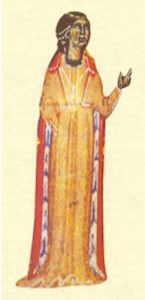While working on my “Female as Shapeshifter” paper, I am beginning to look at some primary sources for inclusion. The first I wanted to work with is a piece from 1566, “The true discripcion of a childe with ruffes borne in the parish of Micheham in the cou[n]tie of Surrey in the yeere of our Lord. M.D.LXvi,” which is in two parts. The first part is a vignette describing the physical attributes of a baby girl born with malformations to her skin. The second part, however, is most interesting as it relies on popular portents that construed birth monstrosities as omens against sinfulness for others, as well as indications of the parents’ transgressions, specifically those of the mother.
Monsters in the medieval period were often thought of as the physical manifestations of sin, and if their purpose was correctly deciphered, could serve as warnings. Similarly, once their significance was understood, they illustrated the sin, fait accompli, which brought them into existence. In my example, the baby with ruffes, or ruffled skin, was the punishment brought upon the mother for her indecent, or immodest wearing of ruffles on her garments. Here is a snippet of the original poem (the entirety of which can be found here):
Her supposed vanity while pregnant was transmitted to the child inside of her, physically shaping the baby in accordance to the mother. Thus this second section is an admonition to women everywhere, reminding them of their responsibilities not only to themselves but to society who entrusts them with the duty of creating future adults.
Just yesterday afternoon I lectured on Susan Sontag’s “A Woman’s Beauty” and in both my classes the discussion turned towards the great facility with which we split off the “inside” from the “outside” when defining beauty, namely in modern culture. There is a strong belief that the two are irreconcilable. It doesn’t help that Sontag attributes this distinction to a Christian era that she believes ostracized women for being attractive. Nevertheless she is not wrong, and this is the double edged sword of beauty – attention to physical appearance is admonished and reprimanded, yet anything less is a portent of a stain upon our hearts. So beauty is a representation of purity, but rejoicing in it is pride, and a sin. Thus in the Christian era Sontag cites, the inside and outside are not mutually exclusive, only reflections of each other.
The woman in my quoted passage, however, is not condemned for flaunting her God-given appearance, but rather for embellishing herself with ruffles (Ruffles!). She may well have been a great beauty, and was immodestly boasting by drawing further attention to herself. Or she may have been rather ordinary looking, or even unattractive, using ruffles to overcompensate for lack of beauty. This does not matter. I am going to completely ignore the insinuation that acquired traits which bear no genetic inheritance are used as an explanation for her baby’s appearance, and rather focus on the social implications that are transmitted by the work. Here pride is not only a punishable sin; pride is a particularly anxiety producing character trait because it reveals the extent to which female comport resides outside the boundaries of societal, and more importantly, male control. The baby inherits her mother’s flaws, genetic or otherwise, and fails to resemble the father, negating the demands of patrilineage. Further, this child does not even so much as resemble the mother but rather holds a mirror to her sinful behavior, providing a double offense to the father who has nothing to show for his role in the process of conception, and now must also suffer a reminder of his wife’s transgressions.
The female body during pregnancy becomes a locus of activity. Her body changes as she shapes and molds the baby inside of her according to her physical appearance, her thoughts, and her behavior. Consequently all of these facets of female existence then need to be controlled in order to ensure proper progeny. This resulted in an abundance of texts produced during the early modern period, specifically intended for women, that admonished unfavorable behaviors in an attempt to eradicate them. While a large portion of these were of course political, and help shed light on some of the controversies of the sixteenth and seventeenth centuries, including the dispute between Puritans and the reforms of Charles I, these are of less concern to me than the regard for the female body during the period of gestation. And as I continue working on my paper I look forward to exploring several other texts as well.
Sources:
Crawford, Julie. Marvelous Protestantism: Monstrous Births in Post-Reformation England.
Crawford, Patricia. “The construction and experience of maternity in seventeenth century England.”
Purkiss, Diane. “Producing the voice, consuming the body: Women prophets of the seventeenth century.”
